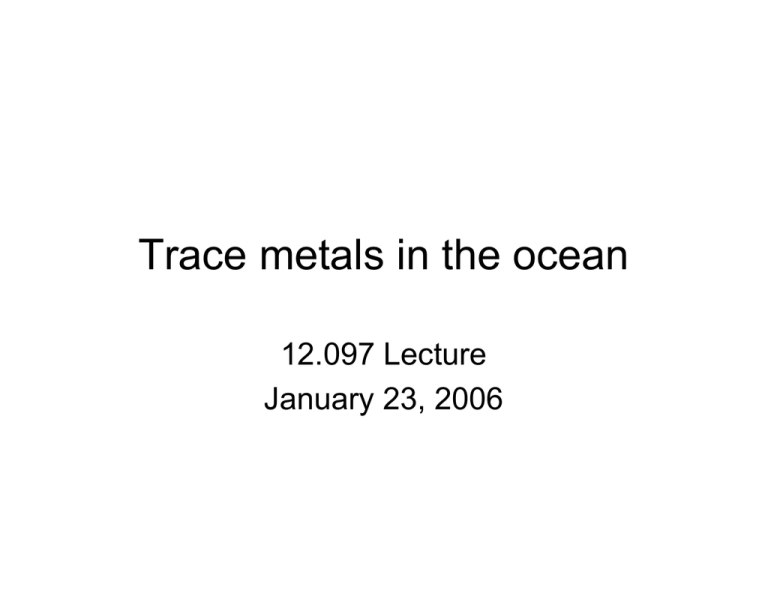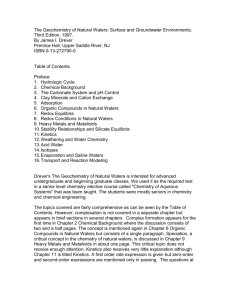Trace metals in the ocean 12.097 Lecture January 23, 2006
advertisement

Trace metals in the ocean 12.097 Lecture January 23, 2006 Metals of interest • Required for metabolic functions – Mn, Fe, Co, Ni, Cu, Zn • • • • • Deficiency limits production (photosynthetic ability) Excess limits growth (cellular biosynthesis) Aqueous concentrations: 10-910-12M Chemical speciation extremely important Large horizontal and vertical concentration / speciation gradients Image removed due to copyright considerations. Please see: Ken Bruland, UCSC. (See readings.) Forms in marine waters • Three forms in aqueous solution: – – – – Free hydrated ions (e.g., Fe+2, Cu+2) Inorganic complexes (e.g., Fe(OH)-) Organic complexes; bound by organic ligands [M]free << [M-L] or [M]Tot • Some metals adsorb to particles and are “scavenged” from aqueous solution during transit to deep ocean • Redox chemistry is important for some metals, especially if solubility changes with oxidation state Vertical profiles – Fe, Mn Images removed due to copyright considerations. Please see: Morel et al., 2003. (See readings.) 1. For each element, left plot is total concentration and right plot is “free” ion concentration. Note the significantly larger concentrations for Mn than Fe. 2. Fe has significant fraction bound by organic ligands (note [L]T > [Fe]T; Mn does not. (no known ligands have been found). 3. Both show increased surface concentrations – due to aeolian input (dust) 4. Both show subsurface maxima associated with O2 minimum 5. In low O2 zones, Mn may have dynamic redox cycle: Mn(II) ↔ Mn(IV) Mn • Highest concentrations in northern Atlantic • Sources – – – – Riverine input Diffusion from shelf sediments Deposition of atmospheric particulates (aeolian dust) Hydrothermal activity (source to deep ocean, not surface) • Mn(II) in oxic waters: soluble but thermodynamically unstable – Exists mainly as Mn+2 or MnCl+ • Mn(IV): insoluble but thermodynamically stable Mn – Redox cycle • • Oxidation of Mn(II) to Mn(IV) is thermodynamically favorable but kinetically slow – thus it must be catalyzed by enzymes Æ Mn(II) to Mn(IV) is microbially-mediated in oxic waters – – – • • • Image removed due to copyright considerations. Please see: tebolab.ucsd.edu/SG-1.jpg Autotrophic process – occurs primarily at oxic / anoxic boundaries Dynamic cycle that is repeated many times before Mn leaves mixed layer Decrease in turnover rate with depth may be due to concomitant loss of organic reducing agents Once formed, Mn(IV) precipitates or adsorbs onto particles and sinks through the water column (both processes are due to formation of MnOx. In sediments, Mn(IV) is reduced to Mn(II) when O2 is low / missing (heterotrophic). Presence of Mn(II) in surface waters is due to photoinhibition of microbially-mediated Mn(II) oxidation (Sunda & Huntsman, 1988) Image removed due to copyright considerations. Please see: lepo.it.da.ut.ee/~olli/eutr/ronniefig6b.png Mn – cellular requirements • Cellular requirement of Mn is very high – Photosynthesis - responsible for water oxidation in photosystem II – Detoxification of O2- radicals – may replace Fe in superoxide dismutase Image removed due to copyright considerations. Please see: www.bio.ic.ac.uk/research/barber/psIIimages/PSII.jpg Image removed due to copyright considerations. Please see: www.sigmaaldrich.com/img/assets/5942/Superoxide-Dismutase.gif Fe – history • Debate: what is limiting growth in high nutrient – low chlorophyll regions? • J. Martin = Fe! • Three iron-fertilization experiments: IronExI, IronExII, SOIREE • Combined results: – Fe(II) additions stimulate photosynthesis – Phytoplankton assemblage changes in composition – Fe may control plankton species if they have different cellular Fe requirements Image removed due to copyright considerations. Please see: www.csa.com/discoveryguides/oceangard/images/soiree.jpg Image removed due to copyright considerations. Please see: Chisholm et al., Nature 2000. (See readings.) Fe • Sources: – Atmospheric aerosols (dust, wet / dry deposition) • Mix of terrestrial weathering products, solids removed by photochemistry and reprecipitation, dissolved metals – Vertical mixing and upwelling – Rivers and bottom sediments – Biogenic recycling in surface waters • Sinks: – Sorption & precipitation Æ sinking particles – Biological assimilation – Aggregation of inorganic / organic colloids upload.wikipedia.org/wikipedia/en/5/51/Sahara_sandstorm.jpg Fe – coastal sources Images removed due to copyright considerations. Please see: Ken Bruland, UCSC. (See readings.) Fe – biological uptake • Fe present in two redox forms: – Fe(II) – soluble in water, quickly oxidized to Fe(III) by O2 in oxic waters – Fe(III) – insoluble in water, forms Fe(OH)x solids • Fe(III) changed to Fe(II) by: – Photochemistry – Enzymatic reduction – Formation of Fe(II) organic complexes • Availability to microbes is function of: – Chemical forms in surrounding environment – Preference of uptake mechanism for specific chemical form – Balance among uptake kinetics, Fe demand, and reaction kinetics between chemical species Image removed due to copyright considerations. Please see: Morel et al., 2003. (See readings.) Fe – cellular roles Image removed due to copyright considerations. Please see: www.ualr.edu/~botany/ps2complex.gif Image removed due to copyright considerations. Please see:Plantnet.rbgsyd.gov.au/PlantNet/cycad/nitrogen/figure17.jpg • Photosystem II – integral in redox cycle of quinones • Nitrogen fixation – integral in nitrogenase (dominant enzyme of process) Other important trace metals • Zn – Used in carbonic anhydrase (CO2 fixation) – Cellular requirement is absolute (death threshold) • Co – May be co-factor in carbonic anhydrase – substitutes for Zn? – Co-factor in cobalamin (Vitamin B12) – Cyanobacteria produce strong Co-binding ligands • Cd – Co-varies with PO4-3 in water column – link? – May be co-factor in carbonic anhydrase – sub for Zn? • Cu – Limitation is rare; can be toxic in coastal environments (common ingredient in anti-biofouling agents) – Plays role in denitrification (reduction of N2O to N2)


